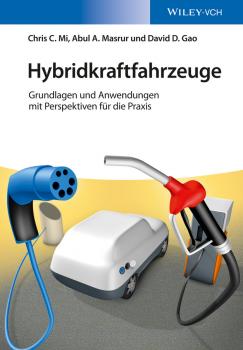Chris Mi
Список книг автора Chris MiHybridkraftfahrzeuge. Grundlagen und Anwendungen mit Perspektiven für die Praxis
Hybridkraftfahrzeuge und Elektroautos spielen fur die Automobilindustrie eine immer wichtigere Rolle. Begrenzte Ressourcen und steigende Kraftstoffpreise pragen die Anspruche von Verbrauchern. Durch energie- und umweltpolitische Vorgaben wird das Interesse an alternativen Antriebsformen zusatzlich gesteigert. Auch in der Lehre an Universitaten und Hochschulen nimmt die die Technologie einen gro?eren Stellenwert ein, neben klassischen Themen der Fahrzeugtechnik gewinnen moderne Hochleistungselektronik und die Entwicklung neuer Materialien fur die Batterie- und Motortechnik an Bedeutung. Leicht nachvollziehbar und mit der langjahrigen Erfahrung aus Industrieforschung, Unternehmensfortbildung und akademischer Lehre vermitteln die Autoren Grundwissen und weiterfuhrende Aspekte. * Grundlagen der Hybridtechnik * Einfuhrung in Speicherelemente wie Batterien, Kondensatoren und Brennstoffzellen * Uberblick uber gangige Hybridisierungskonzepte in Kraftfahrzeugen * Leistungselektronik, Elektromotoren und elektrische Maschinen * Komponentenauslegung und Designoptimierung * Leistungs- und Energiemanagement im Fahrzeug * Zuverlassigkeit, elektromagnetische Vertraglichkeit und Lebensdauer * Entwicklungen bei fortgeschrittenen Architekturen des Hybrid-Antriebsstrangs wie Planetengetriebe, Doppelkopplungsgetriebe und Two-Mode-Hybridsysteme * Modellierung und Simulation auf Basis von MATLAB/Simulink Am Beispiel von Zugen, Flugzeugen, Schiffen und weiteren Transportmitteln wird der Einsatz von Hybridtechnik au?erhalb der Automobilindustrie erlautert. Fragen zu Kommerzialisierung und Standardisierung geben einen Ausblick auf die wirtschaftliche Entwicklung. Das erste in sich abgeschlossene Lehrbuch uber alles, was man alles, was man zu Konzeption und Betrieb von Hybridfahrzeugen wissen muss.
Hybrid Electric Vehicles. Principles and Applications with Practical Perspectives
The latest developments in the field of hybrid electric vehicles Hybrid Electric Vehicles provides an introduction to hybrid vehicles, which include purely electric, hybrid electric, hybrid hydraulic, fuel cell vehicles, plug-in hybrid electric, and off-road hybrid vehicular systems. It focuses on the power and propulsion systems for these vehicles, including issues related to power and energy management. Other topics covered include hybrid vs. pure electric, HEV system architecture (including plug-in & charging control and hydraulic), off-road and other industrial utility vehicles, safety and EMC, storage technologies, vehicular power and energy management, diagnostics and prognostics, and electromechanical vibration issues. Hybrid Electric Vehicles, Second Edition is a comprehensively updated new edition with four new chapters covering recent advances in hybrid vehicle technology. New areas covered include battery modelling, charger design, and wireless charging. Substantial details have also been included on the architecture of hybrid excavators in the chapter related to special hybrid vehicles. Also included is a chapter providing an overview of hybrid vehicle technology, which offers a perspective on the current debate on sustainability and the environmental impact of hybrid and electric vehicle technology. Completely updated with new chapters Covers recent developments, breakthroughs, and technologies, including new drive topologies Explains HEV fundamentals and applications Offers a holistic perspective on vehicle electrification Hybrid Electric Vehicles: Principles and Applications with Practical Perspectives, Second Edition is a great resource for researchers and practitioners in the automotive industry, as well as for graduate students in automotive engineering.
Wireless Power Transfer for Electric Vehicles and Mobile Devices
From mobile, cable-free re-charging of electric vehicles, smart phones and laptops to collecting solar electricity from orbiting solar farms, wireless power transfer (WPT) technologies offer consumers and society enormous benefits. Written by innovators in the field, this comprehensive resource explains the fundamental principles and latest advances in WPT and illustrates key applications of this emergent technology. Key features and coverage include: The fundamental principles of WPT to practical applications on dynamic charging and static charging of EVs and smartphones. Theories for inductive power transfer (IPT) such as the coupled inductor model, gyrator circuit model, and magnetic mirror model. IPTs for road powered EVs, including controller, compensation circuit, electro-magnetic field cancel, large tolerance, power rail segmentation, and foreign object detection. IPTs for static charging for EVs and large tolerance and capacitive charging issues, as well as IPT mobile applications such as free space omnidirectional IPT by dipole coils and 2D IPT for robots. Principle and applications of capacitive power transfer. Synthesized magnetic field focusing, wireless nuclear instrumentation, and future WPT. A technical asset for engineers in the power electronics, internet of things and automotive sectors, Wireless Power Transfer for Electric Vehicles and Mobile Devices is an essential design and analysis guide and an important reference for graduate and higher undergraduate students preparing for careers in these industries.
Automotive Power Transmission Systems
Provides technical details and developments for all automotive power transmission systems The transmission system of an automotive vehicle is the key to the dynamic performance, drivability and comfort, and fuel economy. Modern advanced transmission systems are the combination of mechanical, electrical and electronic subsystems. The development of transmission products requires the synergy of multi-disciplinary expertise in mechanical engineering, electrical engineering, and electronic and software engineering. Automotive Power Transmission Systems comprehensively covers various types of power transmission systems of ground vehicles, including conventional automobiles driven by internal combustion engines, and electric and hybrid vehicles. The book covers the technical aspects of design, analysis and control for manual transmissions, automatic transmission, CVTs, dual clutch transmissions, electric drives, and hybrid power systems. It not only presents the technical details of key transmission components, but also covers the system integration for dynamic analysis and control. Key features: Covers conventional automobiles as well as electric and hybrid vehicles. Covers aspects of design, analysis and control. Includes the most recent developments in the field of automotive power transmission systems. The book is essential reading for researchers and practitioners in automotive, mechanical and electrical engineering.



